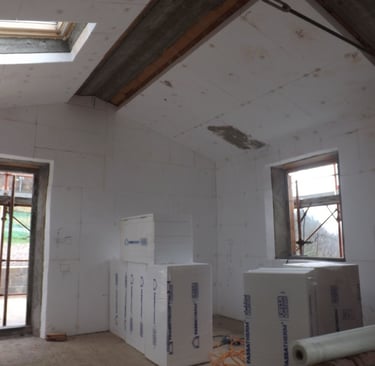Energy Smart, Wallet Happy: The Real Value of Insulation and Energy Certificates
John Heseltine
Why insulation (and energy certificates) really matter
Energy certificates aren’t the most exciting subject in the world. Those funny square stickers you see on anything that uses electricity—like a toaster or an oven—they look like rainbows with a little arrow and some blurb. Not very interesting, and quite often, they don’t seem to make much difference to what people buy.
But as things get larger, the numbers become more important—the sort of numbers that might mean the difference between a few hundred euros and a few thousand, possibly even tens of thousands.
When we built the new house at La Rupina, we knew we wanted to make it as comfortable as possible. Weather in the mountains can be pretty cold—winter temperatures can drop below minus 20°C at night.
Our house was built with 10 cm of insulation on all external-facing surfaces. Our windows are 40 mm double-glazed, argon-filled glass with UV-reflective coating. Even our front door is 7 cm of old chestnut with insulation sandwiched inside.
Our heating system was also designed to be super efficient. We have three interconnected systems:
Two large solar panels on the roof with a 300-litre accumulator tank,
A wood stove with a back boiler, and
A gas boiler connected to both systems through a series of heat exchangers, valves, and sensors.
The combination of a lot of insulation plus a clever (yet simple and reliable) heating system means that our house scores very highly on its Energy Certificate.
These certificates are broadly split into seven groups, from A to G. Within the A group, there are four sub-groups: A1, A2, A3, and A4, with A4 being the highest level possible. La Rupina scores an A3, which is just one level below the highest score a building can receive.
Understanding energy certificates
Energy certificates are useful because they allow you to compare one building with another. In Italy, energy certificates are known as Attestato di Prestazione Energetica or APE. These are not records of actual energy consumption—they're calculations. Specifically, they estimate the number of kilowatt-hours (kWh) each square meter of a building needs to maintain a temperature of 20°C (this may vary slightly by country), averaged out over a year.
The calculation also includes the energy required to provide hot water for a sufficient number of occupants. This creates a standardised measurement that allows buildings to be compared fairly.
Because the number is given per square meter, we can do a simple calculation to compare two properties. Let's use La Rupina (120 m²) as an example and compare it with a hypothetical house of the same size but without insulation.
Calculate the theoretical energy consumption
Sample uninsulated House
A typical older, poorly insulated property in Europe may have an annual energy consumption of 250 kWh/m².
So:
120 m² x 250 kWh = 30,000 kWh per year
Energy content of butane heating gas: 12.8 kWh/kg
1 litre of butane weighs 0.585 kg
Therefore, 1 litre of butane produces:
12.8 x 0.585 = 7.488 kWh/litre
To get the total litres of butane required:
30,000 kWh ÷ 7.488 kWh per litre = 4,006 litres of butane
Current price for bulk delivery of butane is around €0.75 + 22% tax per litre:
(4,006 x 0.75) x 1.22 = €3,665.49 per year
That's €70.50 per week for heating and hot water.
Well insulated La Rupina
Our energy certificate says La Rupina consumes 37.63 kWh/m² per year:
120 m² x 37.63 = 4,515.60 kWh
4,515.60 ÷ 7.488 = 603 litres of butane
Cost:
(603 x 0.75) x 1.22 = €551 per year
That's €10.59 per week for heating and hot water.
Six-Year Comparison
Uninsulated house:
€3,665.49 x 6 = €21,992 (approx. €70.48/week)La Rupina:
€551 x 6 = €3,306 (approx. €10.59/week)
Savings over six years: €18,686
Theory is fine but what about real-world use?
Now, the sample house probably wouldn’t have spent €70.48 per week on energy. In reality, people in poorly insulated homes usually turn the heating down to save money. Maybe they’d reduce energy use to about €23.50/week—but that comes at a cost to comfort:
Some rooms (like storage areas, hallways, and toilets) wouldn’t be heated at all.
Bathrooms would be just warm enough to use—getting out of the shower might mean stepping into a freezing room.
Bedrooms wouldn’t be heated, so you’d wake up to frost on the inside of the windows.
Usually, only one room—the kitchen—is kept warm, because that’s where everyone gathers in winter.
I know this because I speak from experience.
Our Real Numbers at La Rupina
In our garden, we have a 1,500-litre gas tank that supplies butane to the house. In 2017, it was filled to 82% capacity. The house has been occupied most winters since then. Today, the tank still sits at 34%—and it has never been refilled.
We also get deliveries of seasoned firewood. We are currently at the end of our last delivery which we got three years ago.
My best estimate is that our real total cost of heating and hot water is about €5 per week.
And at €5 a week, La Rupina is not just warm in the winter and cool in the summer—it’s comfortable even with the heating off, thanks to the thermal store and other design features.
But more on those in another blog.
The Bottom Line
This is why insulation is probably the most cost-effective way to reduce your energy bills and improve comfort. Energy certificates are incredibly useful tools for comparing properties and understanding long-term running costs.
Hope you found this useful.
Cheers,
John

